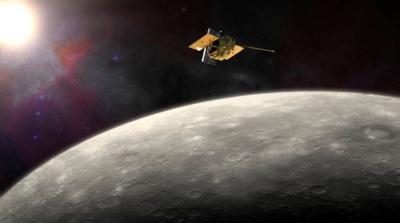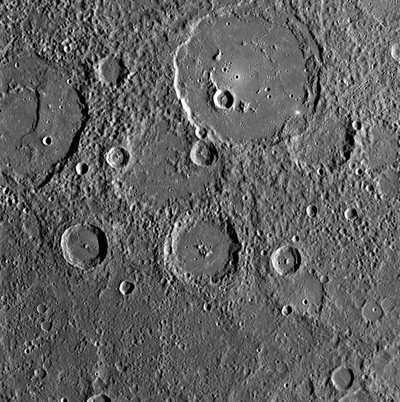MESSENGER Spacecraft Will Impact Planet's Surface At The End Of The Month
After extraordinary science findings and technological innovations, a NASA spacecraft launched in 2004 to study Mercury will impact the planet’s surface, most likely on April 30, after it runs out of propellant.

NASA’s MErcury Surface, Space ENvironment, GEochemistry, and Ranging (MESSENGER) spacecraft will impact the planet at more than 8,750 miles per hour on the side of the planet facing away from Earth. Due to the expected location, engineers will be unable to view in real time the exact location of impact.
On Tuesday, mission operators in mission control at the Johns Hopkins University Applied Physics Laboratory (APL) in Laurel, Maryland, completed the fourth in a series of orbit correction maneuvers designed to delay the spacecraft’s impact into the surface of Mercury. The last maneuver is scheduled for Friday, April 24.
"Following this last maneuver, we will finally declare the spacecraft out of propellant, as this maneuver will deplete nearly all of our remaining helium gas,” said Daniel O’Shaughnessy, mission systems engineer at APL. “At that point, the spacecraft will no longer be capable of fighting the downward push of the sun's gravity.”
Although Mercury is one of Earth’s nearest planetary neighbors, little was known about the planet prior to the MESSENGER mission.
“For the first time in history we now have real knowledge about the planet Mercury that shows it to be a fascinating world as part of our diverse solar system,” said John Grunsfeld, associate administrator for the Science Mission Directorate at NASA Headquarters in Washington. “While spacecraft operations will end, we are celebrating MESSENGER as more than a successful mission. It’s the beginning of a longer journey to analyze the data that reveals all the scientific mysteries of Mercury.”
The spacecraft traveled more than six and a half years before it was inserted into orbit around Mercury on March 18, 2011. The prime mission was to orbit the planet and collect data for one Earth year. The spacecraft’s healthy instruments, remaining fuel, and new questions raised by early findings resulted in two approved operations extensions, allowing the mission to continue for almost four years and resulting in more scientific firsts.
One key science finding in 2012 provided compelling support for the hypothesis that Mercury harbors abundant frozen water and other volatile materials in its permanently shadowed polar craters.

Data indicated the ice in Mercury's polar regions, if spread over an area the size of Washington, would be more than two miles thick. For the first time, scientists began seeing clearly a chapter in the story of how the inner planets, including Earth, acquired water and some of the chemical building blocks for life.
A dark layer covering most of the water ice deposits supports the theory that organic compounds, as well as water, were delivered from the outer solar system to the inner planets and may have led to prebiotic chemical synthesis and, thusly, life on Earth.
“The water now stored in ice deposits in the permanently shadowed floors of impact craters at Mercury’s poles most likely was delivered to the innermost planet by the impacts of comets and volatile-rich asteroids,” said Sean Solomon, the mission’s principal investigator, and director of Columbia University's Lamont-Doherty Earth Observatory in Palisades, New York. “Those same impacts also likely delivered the dark organic material.”
In addition to science discoveries, the mission provided many technological firsts, including the development of a vital heat-resistant and highly reflective ceramic cloth sunshade that isolated the spacecraft’s instruments and electronics from direct solar radiation – vital to mission success given Mercury’s proximity to the sun. The technology will help inform future designs for planetary missions within our solar system.
“The front side of the sunshade routinely experienced temperatures in excess of 300° Celsius (570° Fahrenheit), whereas the majority of components in its shadow routinely operated near room temperature (20°C or 68°F),” said Helene Winters, mission project manager at APL. “This technology to protect the spacecraft’s instruments was a key to mission success during its prime and extended operations.”
The spacecraft was designed and built by APL. The lab manages and operates the mission for NASA's Science Mission Directorate. The mission is part of NASA's Discovery Program, managed for the directorate by the agency's Marshall Space Flight Center in Huntsville, Alabama.
(Images provided by NASA)
 ANN's Daily Aero-Linx (04.15.24)
ANN's Daily Aero-Linx (04.15.24) Classic Aero-TV: 'No Other Options' -- The Israeli Air Force's Danny Shapira
Classic Aero-TV: 'No Other Options' -- The Israeli Air Force's Danny Shapira Aero-News: Quote of the Day (04.15.24)
Aero-News: Quote of the Day (04.15.24) Airborne 04.16.24: RV Update, Affordable Flying Expo, Diamond Lil
Airborne 04.16.24: RV Update, Affordable Flying Expo, Diamond Lil ANN's Daily Aero-Term (04.16.24): Chart Supplement US
ANN's Daily Aero-Term (04.16.24): Chart Supplement US




